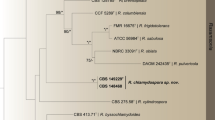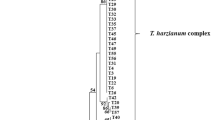Abstract
Keratinomyces ajelloi was first described in 1952 by Vanbreuseghem1, who isolated it from soil by means of a technique2 which consists of placing hair on the surface of the soil in a Petri dish as ‘bait’ for keratinophilic fungi. Since this original isolation, the fungus has been reported many times and is clearly a common inhabitant of soil and of widespread distribution.
This is a preview of subscription content, access via your institution
Access options
Subscribe to this journal
Receive 51 print issues and online access
$199.00 per year
only $3.90 per issue
Buy this article
- Purchase on Springer Link
- Instant access to full article PDF
Prices may be subject to local taxes which are calculated during checkout
Similar content being viewed by others
References
Vanbreuseghem, R., Bull. Acad. Belge, Cl. Sci., 38, 1068 (1952).
Vanbreuseghem, R., Ann. Soc. Belge Méd. Trop., 32, 173 (1952).
Author information
Authors and Affiliations
Rights and permissions
About this article
Cite this article
DAWSON, C., GENTLES, J. Perfect Stage of Keratinomyces ajelloi. Nature 183, 1345–1346 (1959). https://doi.org/10.1038/1831345a0
Issue Date:
DOI: https://doi.org/10.1038/1831345a0
This article is cited by
-
Dermotofitia porTrichophyton ajelloi
Mycopathologia (1982)
-
Beiträge zur Reservoirfrage von Dermatomyceten und zur Frage der Beziehungen zwischen Gymnoascaceen und Dermatomyceten
Mycopathologia (1964)
-
Mycological note
Mycopathologia et Mycologia Applicata (1963)
-
Aislamiento de keratinomyces ajelloi y microsporum gypseum del suelo de la ciudad de buenos aires
Mycopathologia et Mycologia Applicata (1962)
-
Perfect Stage of Microsporum gypseum
Nature (1960)
Comments
By submitting a comment you agree to abide by our Terms and Community Guidelines. If you find something abusive or that does not comply with our terms or guidelines please flag it as inappropriate.



